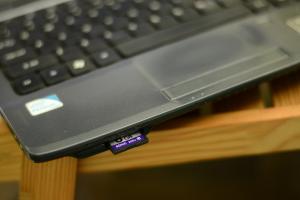Mastering SD Memory Cards: A Comprehensive Guide to Usage, Tips, and Tricks

-
Quick Links:
- 1. Introduction to SD Memory Cards
- 2. Types of SD Memory Cards
- 3. How to Choose the Right SD Card
- 4. How to Use an SD Memory Card
- 5. Formatting Your SD Card
- 6. Transferring Data to and from Your SD Card
- 7. Best Practices for SD Card Maintenance
- 8. Troubleshooting Common SD Card Issues
- 9. Case Studies and Real-World Applications
- 10. FAQs
1. Introduction to SD Memory Cards
Secure Digital (SD) memory cards have become an essential component in the digital landscape, used in everything from cameras to smartphones. Their compact size, versatility, and increased storage capacities have made them a preferred choice for many users. In this guide, we will explore the various aspects of using SD memory cards effectively.
2. Types of SD Memory Cards
There are several types of SD memory cards, each serving different needs:
- Standard SD Card: Typically used in devices like cameras and camcorders.
- SDHC (Secure Digital High Capacity): Supports larger storage capacities from 4GB to 32GB.
- SDXC (Secure Digital eXtended Capacity): For even larger storage, ranging from 32GB to 2TB.
- microSD Card: A smaller version often used in smartphones and tablets.
- microSDHC and microSDXC: Variants of microSD cards that support higher capacities.
3. How to Choose the Right SD Card
When selecting an SD card, consider:
- Storage Capacity: Choose based on your needs, whether for casual storage or professional photography.
- Speed Class: Look for Class 10 or UHS (Ultra High Speed) ratings for faster data transfer.
- Brand Reliability: Opt for reputable brands to ensure quality and longevity.
4. How to Use an SD Memory Card
Using an SD memory card is straightforward:
- Inserting the Card: Locate the SD card slot on your device (camera, laptop, etc.) and insert the card securely.
- Accessing Files: Use your device's file manager to access contents on the card.
- Capturing Media: If using a camera, set it to capture images or videos directly to the SD card.
5. Formatting Your SD Card
Formatting your SD card is essential for optimal performance. Here's how to do it:
- Backup Your Data: Always save a copy of important files.
- Access Settings: Go to your device's settings and find the SD card option.
- Select Format: Choose the format option and confirm.
6. Transferring Data to and from Your SD Card
Transferring data is essential for managing your files:
- Using a Card Reader: Insert the SD card into a card reader connected to your computer.
- File Explorer: Use file explorer to drag and drop files between your computer and the SD card.
- Wireless Transfers: Some devices allow wireless transfer via apps.
7. Best Practices for SD Card Maintenance
To prolong the life of your SD card:
- Avoid Physical Damage: Keep the card in a protective case.
- Safely Eject: Always eject the card safely to prevent data corruption.
- Regular Backups: Regularly backup important files to another storage device.
8. Troubleshooting Common SD Card Issues
If you encounter problems, consider these solutions:
- Card Not Recognized: Try a different device or card reader.
- Data Corruption: Use data recovery software to attempt recovery.
- Slow Performance: Format the card to restore speed.
9. Case Studies and Real-World Applications
SD cards are widely used in various fields:
- Photography: Professional photographers rely on high-capacity SD cards for shoots.
- Data Storage: Businesses use SD cards for secure, portable data storage solutions.
- Mobile Devices: Users expand the storage capacity of smartphones with microSD cards.
10. FAQs
1. What is the difference between SD, SDHC, and SDXC?
SD cards have a maximum capacity of 2GB, SDHC cards range between 4GB to 32GB, and SDXC cards go from 32GB to 2TB.
2. Can I use an SDHC card in an SD card slot?
Yes, SDHC cards are compatible with devices that support SDHC, but not all devices that support SD may support SDHC.
3. How do I know if my SD card is corrupted?
Common signs include files not opening, the card not being recognized, or frequent errors while accessing files.
4. What is the lifespan of an SD card?
The lifespan can vary but generally lasts between 5 to 10 years with proper use.
5. Can I recover data from a corrupted SD card?
Yes, data recovery software can often retrieve files from a corrupted SD card.
6. Is it safe to leave data on an SD card permanently?
It's recommended to back up data from your SD card to another source regularly.
7. What speed class should I choose for video recording?
For video recording, a Class 10 or UHS-I card is recommended for optimal performance.
8. Can I format my SD card on a computer?
Yes, you can format your SD card using your computer's file management system.
9. How do I safely remove my SD card?
Always use the "safely eject" option on your device to avoid data loss.
10. Are all SD cards interchangeable?
While many SD cards are interchangeable, compatibility depends on the device's specifications.
Random Reads
- How to replace flat roof
- How to replace honeywell thermostat batteries
- Quick guide transfer photos ipad
- How to paint plastic furniture
- How to paint concrete statues
- The best way to beat ancano in skyrims eye of magnus quest
- How to make a simple electrical circuit
- How to remove limestone stains
- How to remove linoleum
- How to know chat id telegram android